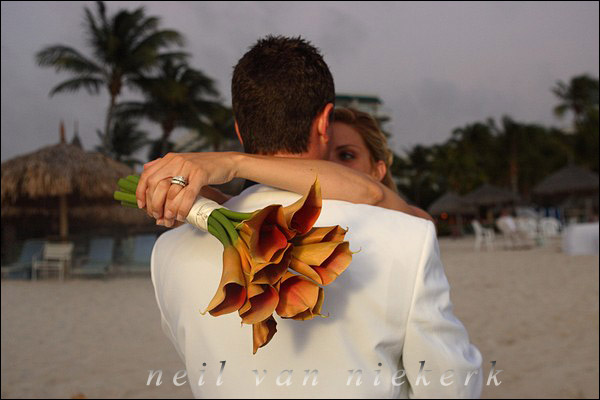
using bounce flash outdoors
While the bounce flash techniques described on these pages are heavily dependent on shooting indoors which provide those places to bounce flash off … it wouldn’t seem possible to use these techniques outdoors. After all, you can’t bounce flash off the clouds. (Although we’ve all seen photographers attempt this outside.)
So while there are obvious limitations in applying these bounce flash techniques outdoors, there are times when these techniques can still be quite effective.
This example, also shown in the tutorial pages is of this image taken at a wedding that I photographed in Aruba.
Here I had my daughter hold up the gold side of the Lastolite reflector. And hopefully this gives the idea of light from the sun setting over the ocean. (It had just gone down, and the light was blandly grey.)
However, these bounce flash techniques do imply some kind of surface to bounce your flash off. But you shouldn’t feel limited by not having an obvious area to bounce light off.
Have a look at this sequence:
Nice evening light:
Settings of .. 1/125th @ f2 @ 1000 ISO .. exposed properly for skin tones and the dress.
BUT, the evening sky and the light from the lamp are lost.
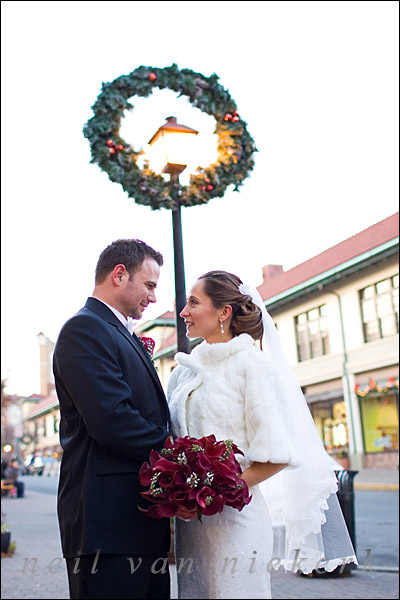
1/250th @ f2 @ 320 ISO …
Nice enough detail in the sky and the lamppost, but the couple is lost in murkiness.
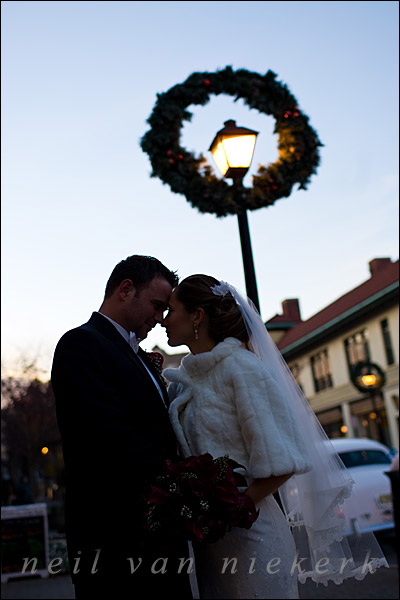
So this is (for me anyway), the kind of opportunity where a touch of flash would work wonders.
So I turned my flash-head 90′ to my left, and bounced light into the shop displays.
Not any particular surface .. just off the general shop displays.
And here are the results, still at 1/250th @ f2 @ 320 ISO.
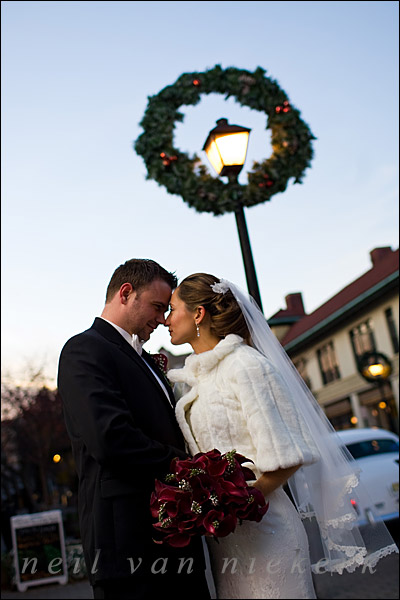
It works for me, and I know my client will love it when she sees it.
To show you exactly what I was bouncing light from, have a look at the shop displays to the left in this test shot:
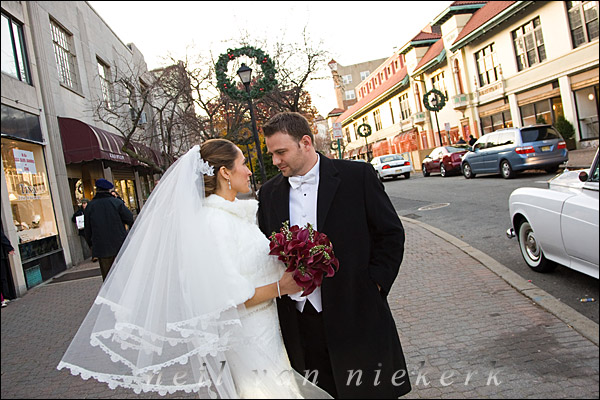
… and this crop from another test shot:
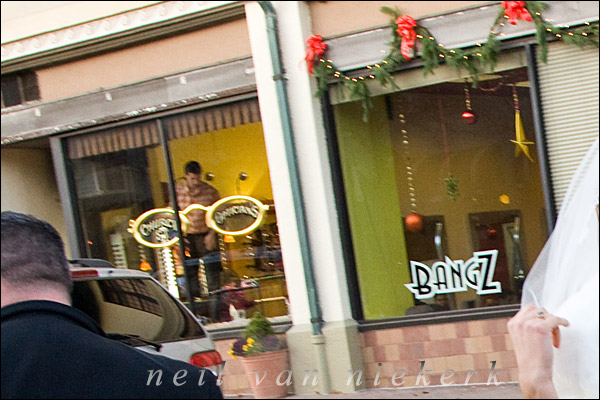
Yup, I bounced flash off that stuff. Nothing in particular .. but, enough light will spill back from whatever is struck by the light from my flashgun .. to give enough light on my couple to enhance the photo.
Here’s another example :
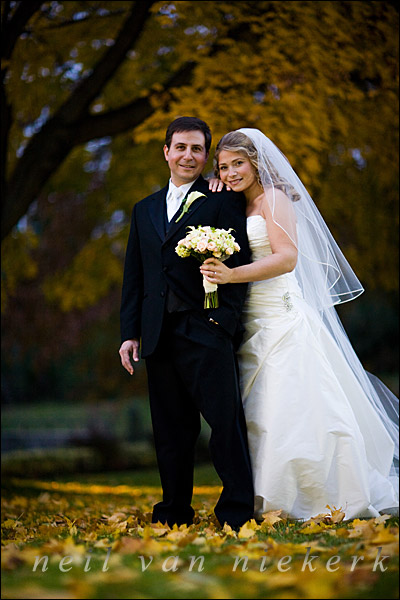
It was really dark already. This was at 1/100th @ f1.2 @ 1250 ISO
Canon 5D and 85mm f1.2 II
I was really squeezing the last bit of light out of the setting we were in. I wanted to use the tree behind them with the last remaining autumn leaves, but the evening light was also coming from behind them. So their faces were shaded. Not good.
I therefore bounced flash off the brick wall of the temple. I’d guess it was about 10 meters from where I was standing. But enough light spilled back to register at that wide an aperture and high an iso. Because the light from the flash is now coming in from an angle, the foreground doesn’t have that typical on-camera flash look to it.
Here’s another image from the same sequence.
(I did edit this though for the dark rings under his eyes from lack of sleep. )
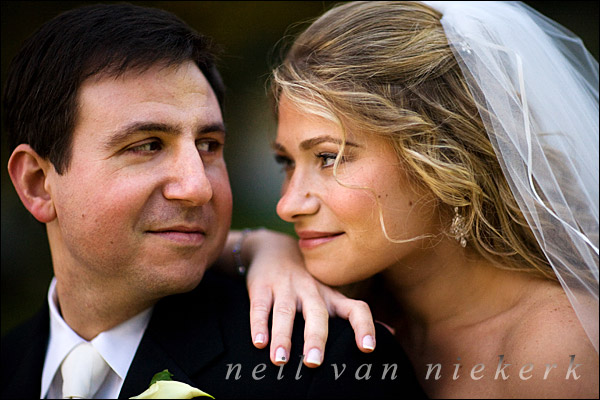
But in this example and the previous one that I show here, I got lucky.
There was some kind of surface or objects nearby to bounce light off.
So, would these techniques work outside ?
Maybe. Quite often not, but sometimes it will. It depends.
It will require some thought.
I am surprised you don’t get a color cast when bouncing a flash of something like a brick wall. Beautiful images nonetheless.
Don’t forget Mac, the most reflective thing on that wall was the glass, which will give an almost mirror copy of the flash copy. Looks like there’s enough there that only the glass would have been hit. A glancing angle does a great job of softening the effect too. I know the truth of this thanks to a recent discovery of how useful glass is when documenting some details in car interiors. The whole interior looked as bright as day thanks to the flash, even though it was 11 at night.
Neil, what can we do for catchlights in the low light situations? I do like the look of the even flash fall-off that bouncing makes, but people I’ve talked to really like to see the eyes jump out a bit to draw attention to that part of the face. Short of finding something small and more reflective to bounce off of in addition to a large surface, I don’t see any alternatives. Do you?
Hi
I love your pictures, and your tutorials are really great and inspiraring. I recently bought a Canon Speedlite EX 580II. Luckely my girlfriend like taking photos too, so se was easy to convince :)
Also we have a Canon EOS 30d camera with a Tamron 17-55 mm 2.8. We are very happy with our equipment.
Your great advice made me want that Speedlite…
How do you keep ISO noise away, when you shoot with high ISO such as 1000 or above?
Neil – what a great resource your site is. I will give you a permanent link how ever you want it from my soon to be photography site.
Thanks, Rob
PS – yes I did the small PP donation – have coffees on me.
Hi Neil, What if you were in the great outdoors, you were in open shade photographing a Family of 13 (getting specific here;~), and you had no buildings or anything (maybe a few trees) to bounce off of? The flash straight on will be to “flashy”…but what about having an assistant stand to your right holding a reflector at a angle to catch aimed bounced flash back onto group? Would that work for directional light, or would there be issues w/shadows then? And would that be enought light bounced back to light entire group? I do studio photography 90% of time & have an upcoming Family shoot this size in Aug. & I’m trying to figure out the best way to do this! :)
I also would like to say your Work & this site are just AMAZING!
Thank You Neil. So if I were to aim my flash (that is on camera) into a large reflector .. so it could bounce flash onto group (of 13!), this would work for lighting group? Where would you suggest to place reflector…(@ 45 deg. angle to subjects @ right possibly)?
Or, do you think it would work at all to light group with on camera flash with a small reflector/diffusser (modifier) attached to flash?
I really don’t have alot of experience with using flash outdoors, ( most the time I’m in studio using strobes). But I just got another job for another group of 12 OUTDOORS in July! So I better get to learning!!
I’m planning to purchase your book that comes out Aug. 1, hopefully it will shed some light (no pun intended ;~) on subject! Anyway I would sure be interested in hearing your reply to my Lengthy question (sorry!). Thank you so much in advance!
Hi neil,
Ive been practicing bouncing flash in my bedroom. Now i often notice you bounce your flash into subjects to the side instead above. When i try to bounce my flash onto a wall to my side, i often get an image that has a very light tone to one side (from the flash) and a darker tone/shadow to the other side. When i look at your pictures, i never see an image that is split in half because of bouncing flash. Can you give me any hints?
Neil, on the example above when you have the couple under the lamp post, instead of bouncing the flash into the shop display, can I just fire the flash straight but using the TTL-BL mode and dial it down using FEC. Will I get the same effect? When will you use TTL-BL and when you will use only TTL like in this example? thanks
Let me see If I understand this, Neil will I get the same result if I meter the sky, then dragged the shutter. bounce the flash the same way as you did.
Also when you said “exposed properly for skin tones and the dress.” that does mean you metered off the couple or just the bride alone (on matrix metering mode.
Do i make any sense. I’m still trying to grasp the triangle of exposure and metering.
Thanks.
Neil I find your article very helpful. I just started practicing Photography and I want to ask how to set my camera in order to avoid blurring images when taking group pictures…..
Also what type of lens is advisable for taking portraits of the two families of a couple on a wedding day
Your most versatile lens for this would be a 24-70mm zoom, or something in that range.
Help me please, People like to hire me for high school prom pictures, the setting are nice this one place they like go is out door at college with lots of trees Lots Shade a small lake waterfall with a bridge rocks fountains shooting in the air docks and gazebo with a wall overlooking out at the lake. I bought my first transmitter for a strobe light do you want to go longer what is stone V860 because I noticed that light mixture isn’t good. Some the subjects come out to dark . I told my wife that I am going to buy a manikin to practice on at this please I need to learn how to use these tools that I got to make the images Look natural. Snapshot; Is my photographer name Benjamin
Your best option here is off-camera flash, using the flash with a softbox on a light-stand.
Your starting point would be to expose for the available light, whether
1. The background is lit, but your subject isn’t. Then you use the flash to lift your subject to about the same exposure as the background.
2. The background and subject is lit about the same, but the light isn’t too flattering. For example, with top-heavy light when the eyes are shaded. Then you expose nearly correctly … but just a touch under … and then lift the exposure that little bit with the off-camera flash.
But generally, when shooting outdoors with flash, you start with the available light, and then decide how you can augment the light with flash.